I’ve always been captivated by the fascinating world of birds. One species that has recently caught my attention is the Chestnut-Bellied Sandgrouse.
Native to parts of Asia and Africa, this bird’s unique characteristics and behavior patterns make it a standout in the avian world.
The Chestnut-Bellied Sandgrouse isn’t just any ordinary bird; it has intriguing features and habits. Sporting a chestnut-colored belly (hence its name), grey head, and speckled wings, it presents as a visual treat for bird watchers. Moreover, their remarkable survival tactics – particularly in arid regions – are something to admire.
Yet, what sets these birds apart is their ability to fly long distances in search of water. They’ve adapted perfectly to thrive in harsh desert environments with scarce resources.
They’re known for undertaking strenuous journeys daily from their nests to watering holes — an incredible testament to their endurance and resilience.
Physical Characteristics of the Chestnut-Bellied Sandgrouse
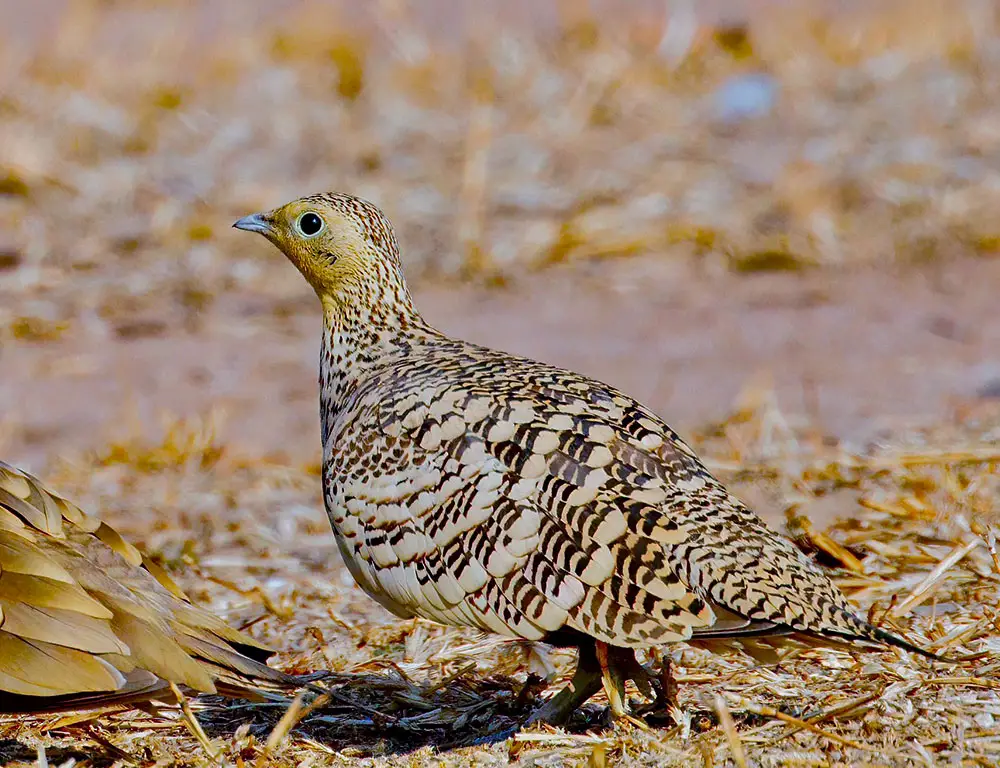
The physical characteristics of the Chestnut-Bellied Sandgrouse are a testament to its adaptation to arid environments and its unique ecological niche.
Here’s an overview of its notable features:
Distinctive Coloration
The Chestnut-Bellied Sandgrouse is named for its chestnut-colored belly, contrasting with its predominantly grey and brown plumage. Male birds also sport a striking black breast-band, adding to their visual appeal.
Size and Weight
These birds are relatively small, measuring around 30 to 35 centimeters in length. They typically weigh between 150 and 200 grams, making them lightweight and agile flyers.
Wingspan
Despite their small size, Chestnut-Bellied Sandgrouse has an impressive wingspan, reaching nearly 50 centimeters. This wingspan allows for efficient flight over long distances, essential for their survival in vast desert landscapes.
Legs and Beak
They have short legs adapted for ground-dwelling activities such as foraging. Their beaks are tiny yet sturdy, ideally suited for pecking at seeds, their primary food source.
Vision
Like many desert-dwelling species, the Chestnut-Bellied Sandgrouse has specialized vision to cope with sandy winds and intense sunlight. This adaptation enables them to navigate their environment effectively and locate resources.
Water Transport Adaptation
One of the most remarkable physical adaptations of the Chestnut-Bellied Sandgrouse is its specialized underbelly feathers. These feathers can soak water like a sponge, allowing the birds to carry water back to their chicks over long distances.
This adaptation is crucial for their survival in arid habitats where water sources are scarce.
Habitat and Distribution of Chestnut-Bellied Sandgrouse
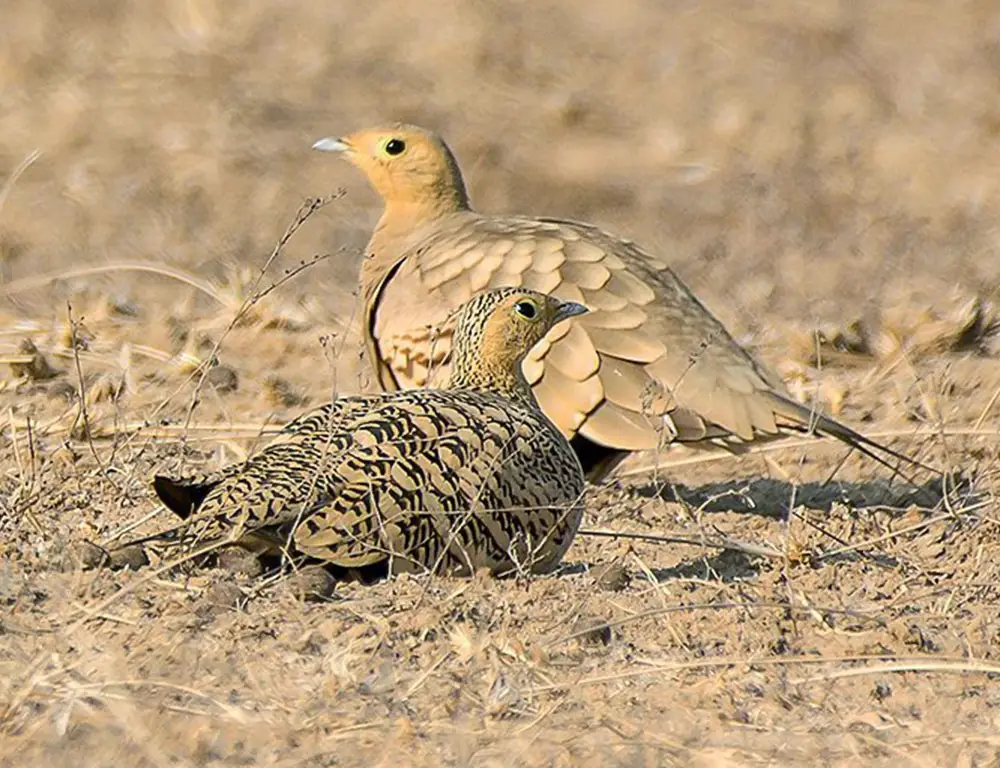
The Chestnut-Bellied Sandgrouse are intriguing birds with a habitat and distribution that reflects their adaptation to semi-desert regions across Africa, the Middle East, and South Asia.
Here’s a closer look at their habitat and distribution:
Geographical Spread
These sandgrouse have a wide-ranging distribution, spanning several countries across three continents:
- Africa: They are found in countries such as Mauritania, Senegal, Mali, Niger, Chad, and Sudan, with their range extending southward to northern Nigeria.
- Middle East: In the Middle East, they inhabit areas of Egypt and Saudi Arabia.
- South Asia: Their presence is notable in Iran, Afghanistan, Pakistan, and India.
Preferred Habitat
Chestnut-Bellied Sandgrouse thrives in semi-desert regions characterized by sandy or rocky terrain and sparse vegetation. They are often found in habitats with thorny bushes scattered across an otherwise barren landscape.
Dry riverbeds, known as wadis, are also favored locations, particularly in the early morning when the birds can access water.
Adaptations to Harsh Conditions
Despite the seemingly harsh living conditions, these sandgrouse have evolved adaptations that enable them to flourish in their environment.
Their earth-toned plumage provides effective camouflage against predators, while their resilient constitution allows them to withstand the extreme heat common in these regions.
Local Movements
While not inherently migratory, Chestnut-Bellied Sandgrouse is known to undertake local movements in response to changes in food availability and climatic conditions.
This behavior allows them to adapt to environmental fluctuations and optimize their survival chances.
Behavior and Diet of Chestnut-Bellied Sandgrouse
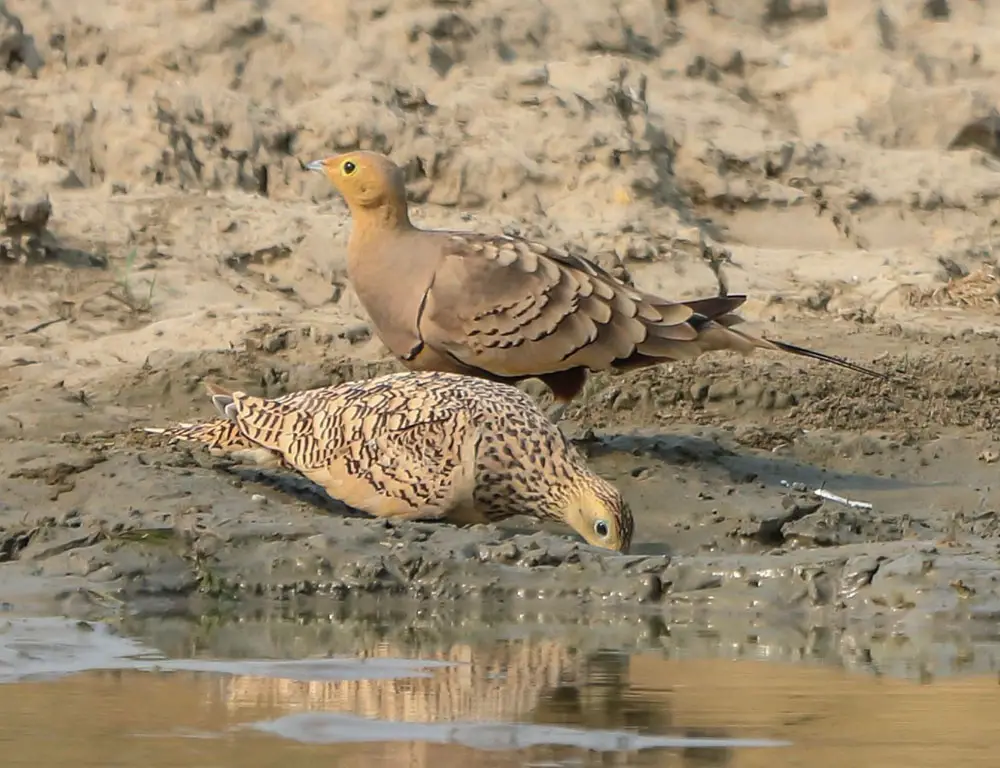
The behavior and diet of the Chestnut-Bellied Sandgrouse are fascinating adaptations to their arid desert habitat, showcasing their resourcefulness and commitment to survival.
Here’s an in-depth look at their behavior and dietary habits:
Behavior
- Habitat and Activity Patterns: Chestnut-bellied sandgrouse primarily inhabit arid areas and are most active around watering holes at dawn and dusk. These times are crucial for them to access water, a scarce resource in their environment.
- Parental Care: A unique behavior of these birds is their adaptation to carry water to their chicks. They soak their belly feathers in water at watering holes and transport them back to their nests, demonstrating remarkable parental care and resourcefulness in ensuring the survival of their offspring.
- Foraging: Chestnut-bellied sandgrouse are ground feeders pecking the earth to find seeds from native plants. During food scarcity, they are known to travel long distances in search of nourishment, highlighting their resilience and adaptability.
- Flexibility: While they typically prefer dawn and dusk activities, Chestnut-Bellied Sandgrouse is not strictly bound to these times.
They will venture out during daylight hours, especially when food or caring for their young requires it, showcasing their flexibility and ability to adjust to changing circumstances.
Diet
- Granivorous Diet: Their diet primarily consists of seeds from various native plants in their habitat. They have evolved specialized beaks for efficiently cracking open seeds and extracting nutrients, allowing them to thrive on a diet of seeds.
- Supplementary Food: Despite being primarily granivorous, Chestnut-Bellied Sandgrouse supplements their diet with small insects when possible. This dietary flexibility enables them to maximize their food resources, especially during scarcity.
Reproduction and Nesting Habits of Chestnut-Bellied Sandgrouse
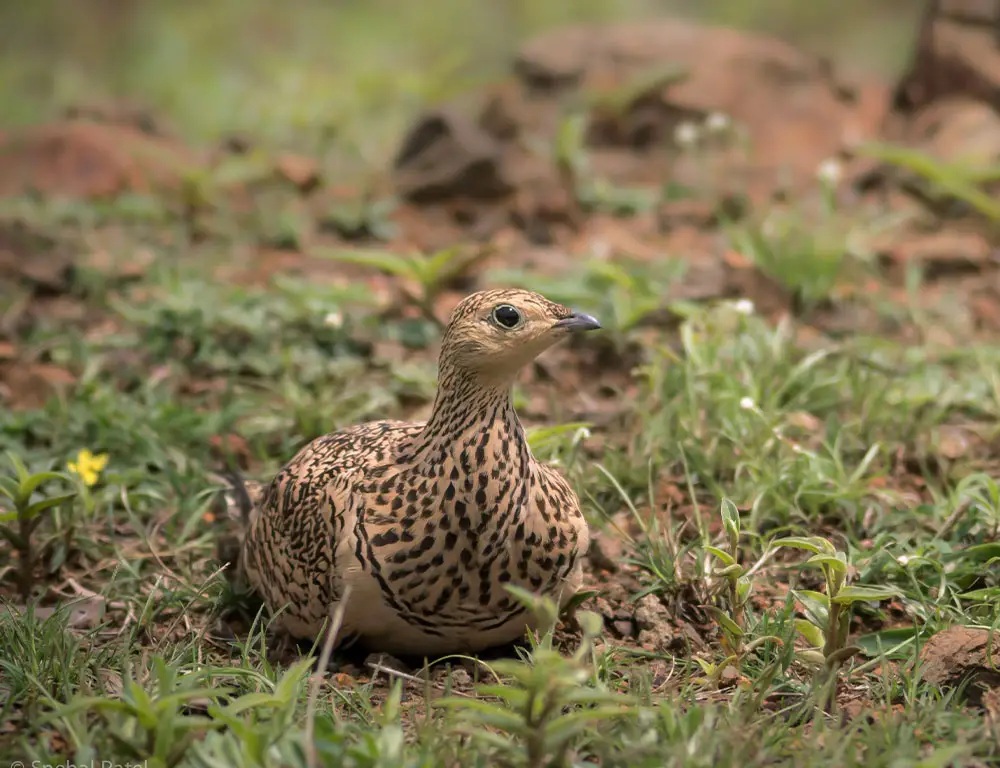
The Chestnut-Bellied Sandgrouse exhibits fascinating reproductive and nesting habits that are well-suited for their arid habitat:
Breeding Season
The breeding season for Chestnut-Bellied Sandgrouses typically occurs between April and September. This period likely coincides with favorable environmental conditions for raising offspring, such as increased food availability or milder temperatures.
Number of Eggs
Females lay relatively small clutches of eggs, typically 2-3 eggs at a time.
This conservative reproductive strategy may be an adaptation to ensure that each chick receives sufficient parental care and resources for survival, considering the challenges of their desert environment.
Incubation Period
Both male and female sandgrouses are responsible for incubating the eggs. The incubation period lasts approximately 20 days, during which the parents must carefully regulate the nest’s temperature and humidity to ensure the embryo’s development.
Parental Care
Once the chicks hatch, they are precocial, meaning they are relatively independent and mobile shortly after birth.
This allows them to follow their parents and feed themselves shortly after hatching, reducing their vulnerability to predation and other environmental threats.
Water Transport
One of the most remarkable aspects of parental care in Chestnut-Bellied Sandgrouses is their ability to transport water to their chicks. In the desert habitats where they live, water sources may be scarce and located far from the nesting sites.
To ensure the survival of their offspring, parent sandgrouses use their specially adapted belly feathers to soak up water and carry it back to the nest, where the chicks can drink and stay hydrated.
Chick Independence
Despite being relatively independent from birth, the chicks still rely on parental care for a significant period. They become fully independent after approximately 40 days, during which time they continue to learn essential survival skills from their parents.
Conservation Status of the Chestnut-Bellied Sandgrouse
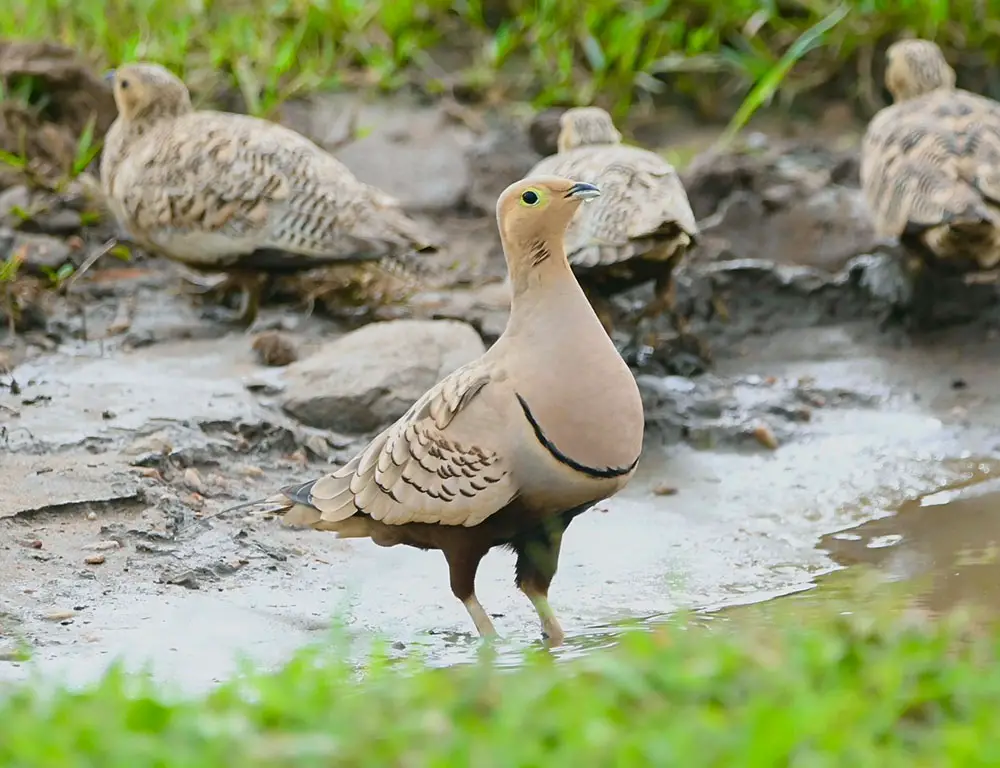
The Chestnut-Bellied Sandgrouse (Pterocles exustus) is currently classified as “Least Concern” by the International Union for Conservation of Nature (IUCN). This designation indicates that the species is not facing immediate extinction risks.
However, several factors threaten its population, and proactive conservation efforts are necessary to ensure its long-term survival.
Factors contributing to the conservation status of the Chestnut-Bellied Sandgrouse include:
Habitat Loss
Human activities such as deforestation, agricultural expansion, and development lead to the loss and fragmentation of the sandgrouse’s natural habitat. This habitat loss can restrict the bird’s ability to find suitable nesting sites and food sources.
Hunting
In some regions, particularly in parts of India, hunting poses a significant threat to the Chestnut-Bellied Sandgrouse population. Unregulated hunting can lead to declines in local populations and disrupt breeding dynamics.
Climate Change
The impacts of climate change, including shifts in temperature and precipitation patterns, can alter the availability of resources such as water and food for the sandgrouse. These changes may affect breeding success and overall population health.
To mitigate these threats and ensure the continued survival of the Chestnut-Bellied Sandgrouse, several conservation measures can be implemented:
Increasing Awareness
Educating the public about the importance of conserving the Chestnut-Bellied Sandgrouse and its habitat can help garner support for conservation efforts.
Enforcing Hunting Laws
Implementing and enforcing strict regulations on the hunting and trade of the sandgrouse can help reduce poaching pressure and protect populations from overexploitation.
Habitat Preservation
Establishing and managing protected areas encompassing key sandgrouse habitats can safeguard critical breeding, feeding, and roosting sites.
Research and Monitoring
Continued research efforts are needed to understand better the ecology, behavior, and population dynamics of the Chestnut-Bellied Sandgrouse. Monitoring populations over time can help assess the effectiveness of conservation measures and identify emerging threats.
| Region | Estimated Population |
|---|---|
| Africa | 1000-10k individuals |
| Asia | 10k-100k individuals |
Conclusion
My exploration of the Chestnut-Bellied Sandgrouse has led me to some fascinating discoveries. This bird species stands out in the avian world with its distinctive features and habits.
The Chestnut-Bellied Sandgrouse is quite adept at survival. Its ability to fly long distances in search of water bodies exemplifies its resilience. The male’s unique method of hydrating the chicks further underscores this species’ adaptability.
Regarding its distribution, it’s interesting that these birds are predominantly found in Northern Africa and India. They thrive in arid regions where temperatures can be extreme. It shows their remarkable endurance.
One aspect I’d like to emphasize is conservation efforts for this species. Although not endangered currently, they might face threats due to habitat loss or changes in climate patterns.
Here are a few key points about the Chestnut-Bellied Sandgrouse:
- They have an exceptional capability for long-distance flights.
- Males play a vital role in chick hydration.
- Predominantly distributed across Northern Africa and India.
- Conservation efforts are crucial for their future survival.
In my research on the Chestnut-Bellied Sandgrouse, I’ve grown more appreciative of nature’s diversity and adaptability. I hope you, too, share my fascination with this remarkable bird species after reading through this article!
Lastly, remember that every creature plays a significant role in our ecosystem – including the humble Chestnut-Bellied Sandgrouse.
As we continue exploring and learning about various wildlife species, we’ll hopefully develop an even more profound respect for our natural world and work towards protecting it.